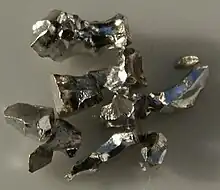
Iridium is the chemical element with symbol Ir and atomic number 77. A very hard, brittle, silvery-white transition metal of the platinum family, iridium is the second-densest element (after osmium) and is the most corrosion-resistant metal, even at temperatures as high as 2000 °C. Iridium was discovered in 1803 among insoluble impurities in natural platinum. Smithson Tennant, the primary discoverer, named the iridium for the Greek goddess Iris, personification of the rainbow, because of the striking and diverse colors of its salts. Iridium is one of the rarest elements in the Earth's crust. 191Ir and 193Ir are the only two naturally occurring isotopes of iridium as well as the only stable isotopes; the latter is the more abundant of the two.
Iridium is found in meteorites with an abundance much higher than its average abundance in the Earth's crust. For this reason the unusually high abundance of iridium in the clay layer at the Cretaceous–Paleogene boundary gave rise to the Alvarez hypothesis that the impact of a massive extraterrestrial object caused the extinction of dinosaurs and many other species 66 million years ago. It is thought that the total amount of iridium in the planet Earth is much higher than that observed in crustal rocks, but as with other platinum group metals, the high density and tendency of iridium to bond with iron caused most iridium to descend below the crust when the planet was young and still molten. (see more...)